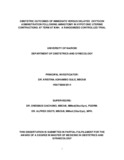Obstetric Outcomes of Immediate Versus Delayed Oxytocin Administration Following Amniotomy in Hypotonic Uterine Contractions at Term at Knh: a Randomized Controlled Trial
Abstract
Background
Amniotomy or Artificial Rupture of Membranes (ARM)/ and Oxytocin administration (OA) are integral parts of active management of labour. Literature is scanty regarding the optimal timing of OA after ARM. Obstetric and neonatal outcomes in expedited versus delayed oxytocin administration succeeding ARM has not been undertaken in our setting despite routine administration of OA after ARM in selected mothers. Evaluating the effect of immediate versus delayed oxytocin administration after ARM for hypotonic uterine contractions on obstetric and perinatal outcomes is critical to maximize the benefits to both the mother and newborns.
Study Objectives
To compare the obstetric outcomes among parturients randomized to immediate versus delayed oxytocin administration after amniotomy for hypotonic uterine contractions at Kenyatta National Hospital between February and July 2018.
Study Site
Kenyatta National Hospital Labour Ward.
Study Design
A pragmatic, single blind Randomized Controlled Trial conducted among women in labour with no contraindications to ARM, vaginal delivery or OA. The intervention and the control arms entailed ARM and OA within 15- 30 minutes and 2 hours respectively. The investigators evaluated the maternal and neonatal outcomes after the two
approaches. Continuous variables were summarized using means and standard deviations. Categorical variables were summarized using counts and proportions and compared between the study groups. Proportions were compared using Chi2 test, 95% CI, two tailed hypothesis with p-value significant at p<0.05.
Results
There were no statistically significant differences in the social- demographic and obstetric characteristics of the participants between the two arms. There were no statistically significant differences in the primary and secondary outcomes between the two arms.In the delayed arm 27.7% of women avoided oxytocin. The mean amniotomy to vaginal delivery interval in the immediate oxytocin administration arm was 277min while that in the delayed oxytocin administration arm was 298 min(P=0.418). The mean amniotomy to decision for cesarean section interval in the immediate oxytocin arm was 345 min and that in the delayed oxytocin arm was 338min(P=0.458).. APGAR score at 5’ was 8.53 and 8.56 in the immediate and delayed arms respectively ( P=0.793). Maternal satisfaction was 4.25 and 4.26 (on a Likert scale of 1 to 5) in the immediate and delayed arms respectively ,P=0.941.
Conclusions
Among women with hypotonic uterine contractions at ≥ 4 cm cervical dilation administering oxytocin immediately (within 15-30 minutes) following ARM does not reduce duration of labour, lower cesarean section rate, improve neonatal outcomes or enhance maternal satisfaction. Delaying oxytocin administration by 2 hours decreases the need for oxytocin by 28%.
Recommendations
In women at term with a favourable Bishop’s score, administration of oxytocin following ARM should be delayed by at least 2 hours.This can avoid oxytocin use by 27.7% It is also encouraged that labour augmentation protocols be developed in KNH. Adherence to partograms in high patient burden settings should be strengthened for early detection of hypotonic uterine contractions and subsequent appropriate interventions.
Publisher
University of Nairobi
Subject
a Randomized Controlled TrialRights
Attribution-NonCommercial-NoDerivs 3.0 United StatesUsage Rights
http://creativecommons.org/licenses/by-nc-nd/3.0/us/Collections
The following license files are associated with this item:


